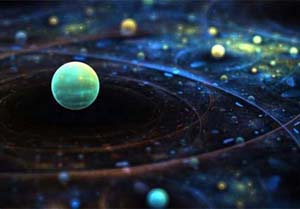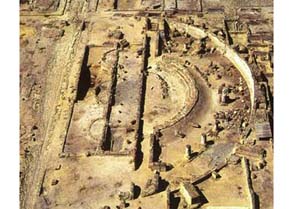 |
|
| Appunti scientifiche |
|
 |
|
| Appunti scientifiche |
|
| Visite: 2121 | Gradito: |
Leggi anche appunti:Il pianeta Terra: casa dell'uomoIl pianeta Terra: casa dell'uomo La terra č il pianeta su cui vive l'umanitą, Flatland: a journey to the discovery of many dimensionFLATLAND: A JOURNEY TO THE DISCOVERY OF MANY DIMENSION L'atmosferaL'atmosfera Il |
 |
 |
FLATLAND: A JOURNEY TO THE DISCOVERY OF MANY DIMENSION

Mathematic Reason and Imagination will help to reveal the Truth.
"Flatland: a romance of many dimensions" is one of the most worldwide known and
appreciated novels, which concern with Mathematics and Scientific subjects. Written by
Edwin Abbott Abbott and published anonymously in 1882, the book is even more read in
the present, when, after the appearance of new revolutionary scientific theories, the
problem of dimensions has become topical and necessary to understand the laws which
regulate our Universe. But Flatland isn't a mere treatise of Geometry, it is at first a story:
the fantastic, ironical, adventurous story of a world, absurd and paradoxical, but strangely
not too different from ours.
 EDWIN ABBOTT
ABBOTT: A LIFE DEVOTED TO CULTURE
EDWIN ABBOTT
ABBOTT: A LIFE DEVOTED TO CULTURE
Edwin Abbott Abbott was born in London in 1838, son of Edwin Abbott, headmaster of the Philological School in Marylebone. He attended the St John's College in Cambridge, where he excelled in
both Classics and Mathematics. He was also very interested in
Theology and in 1862 he took orders. At the early age of twenty-six
he became the headmaster of the City of London School. He
reintroduced the traditional pronunciation of the Latin and promoted
a Philology class, which reached the level of the best Colleges. In
1889 he retired and devoted his life to cultural pursuits. A
biographer writes "He burnt with intellectual energy" . He considered E. A. Abbott
culture a sort of religion. He wrote more than fourty books, dealing with the most different
subjects. From education, to science, to philology, to theology. All his works are
characterized by an ironical and liberal way of analysing the world. He died in 1926.
FLATLAND: THE STORY OF A BIDIMENSIONAL WORLD
' Imagine a vast sheet of paper on which straight Lines, Triangles, Squares, Pentagons,
Hexagons, and other figures, instead of remaining fixed in their places, move freely about,
on or in the surface, but without the power of rising above or sinking below it, very much
like shadows -- only hard with luminous edges -- and you will then have a pretty correct
notion of my country and countrymen.'
This is the simple and original idea at the basis of the book. The main character, which is
also the narrator, is an argute square, called simply A. Square, who describes his world
and his fantastic experience of discovering the third dimension. The book is distinctly
divided in to two very different parts. The first one
deals with
the precise and funny description of 
the features of Flatland, its inhabitants, and the
institutions, which regulate their lives. In the
second part a Sphere introduces A. Square to
Spaceland and to other worlds. This bipartition
isn't just a narrative device, but it reflects a
precise intention of the author, which builds the
story on two different sides, corresponding to two different aims, he wants to reach. These aims are explicitated in the dedication of the book.
The book, as the Square says, is dedicated to the inhabitants of Space, in the
hope that they would aspire higher and higher to the secrets of five, six, even seven
dimensions, thereby contributing "To the enlargement of the imagination and the
possible development of that most rare and excellent gift of modesty among the superior
races of solid humanity". Imagination is the quality which allows, with the contribute of
mathematic knowledge, to reach the truth. But the result isn't only an increasement of knowledge, it is also SOCIAL. The discovery of other dimensions shows that our world isn't the only one, existing. We believe that we are the centre of the Universe, while we are just as the poor squares, triangles and other figures, confined in our dimension. We have to learn modesty, while increasing knowledge.
FLATLAND AS A SATIRE OF VICTORIAN SOCIETY
The most remarkable thing about this novel is the incredibly precise description of an invented world. Life on a plane may seem quite impossible: figures can only slip on it and all they can see on their horizon is a line. Abbott ideates some genial devices and rules, which can regulate and make all aspects of this sort of life possible, with a precision which recalls the assiomatic and deductive approach of Mathematics. The inhabitants of Flatland are polygons, whose social class depends on the number of their sides. The Triangles, who have only three sides, are the bottom of social
ladder, while the Priests are multi-sided polygons and they approximate circles, which are
considered the perfect figures. The population can evolve thanks to the fact that a male child should have one more side than his father.
The situation is different for irregular figures and women.
Only
regular polygons have rights in this society, while irregular ones are
subjected to a severe 
regulation. In particular Isoscel Triangles can't
evolve and are confined to their social class.
They are very dangerous, since their angle is
very sharpened, but they are generally
unintelligent too. But the condition of women is even worse. They are so thin triangles, that they approximate lines, A little Hexagon frightened by a "Quite-Circle" the result is that in some positions they are seen as points.
But the most interesting thing is that they are considered inferior to male figures, because they develop in their personality Emotion more than Ration.
"About three hundreds years ago, it was decreed by the Chief Circle that, since women are deficient in Reason but abundant in Emotion, they ought no longer to be treated as rational, nor receive any mental education."
Each figure in Flatland appears as a line, if seen by another plane figure. They can recognize people by touching each other, or by the superior " Art of Sight Recognition". The more evolved
figures in fact can determine the depth of an object thanks to the presence of fog, which
is very common in Flatland. Even though they can see nothing more than lines, they can
infer angles and other geometrical concepts with great precision. But Abbott sketches
these figures and their society with so great abundance of particulars, that it's really
impossible to summarize it. The incredible fact is that it's very similar to ours. Many
readers of Flatland have considered the book a sort of satire of Victorian society, as it was
during Abbot's life, and a satire of societies in general, as they are also now. The greatest
of problems of Flatland is the condition of life for women. We must say that Abbott was a
supporter of equality of educational opportunity, in particular for women. For the truth at
that time women could get an education, but it was very difficult for them to be accepted
into Universities and Abbott's daughter had experienced it. Abbott recognized also the
existence of two different cultures. Men represent the rational and scientific one, while
women the emotional one. Even though the narrator (which is a male figure) apparently
approves his society and agrees with the point of view of the majority, we understand that
the position of the author is different. And it's expressed by the words of the Sphere, who
introduces a doubt, the possibility of a different point of view: "It is not for me to classify
human faculties according to merit. Yet many of the best and wisest in Spaceland think
more of the affections than of the understanding, more of your despised Straight Lines
than of your belauded Circles." An other interesting satirical element is the position of
Irregular figures. In Victorian Society omologation was the basis of civil life. Irregularities,
unusual behaviours, were always connected with criminal tendencies and deviant
personalities. Abbott exaggerates the situation: irregulars are eliminated in Flatland society
ore used as objects in schools to be studied by regular pupils. Then they are left to starve
to death. The satirical intent is even too evident in this page. In the end he deals with the
problem of freedom of thought and expression. In fact the Square is imprisoned because
he had revealed the existence of an other world, which may have the consequence of
troubling their static society. Which solution does Abbot propose? An incrementation of
modesty in people, who are no more than points or figures in the immensity of space.
A SQUARE: A SECOND PROMETHEUS IN THE DISCOVERY OF SPACE
'Either this is madness or it is Hell.' 'It is neither,' calmly replied the voice of the Sphere,
'it is Knowledge; it is Three Dimensions"
The adventurous part of the book begins with the appearance of a strange visitor in the
A. Square's house, on the first day of the Third Millenium. The night before A. Square had
had a singular dream. He had dreamt about a one dimensional
 world, Lineland, where beings are
segments on
world, Lineland, where beings are
segments on
the same straight line. Their horizon is only a point and they
communicate by using sounds. A. Square tries to reveal to the Monarch of this world the existence of the second dimension, but he discovers that it's impossible to make him realize that his line isn't the entire world. "He was persuaded that the Straight
Line which he called his Kingdom, and in which he passed his A. Square staring to Lineland
existence, constituted the whole of the world, and indeed the whole of Space. Not being
able either to move or to see, save in his Straight Line, he had no conception of anything
out of it."
The day after A. Square receives the visit of a strange figure: a perfect Circle, who can
change his measures and even disappear from the world! After a moment of terror,
Sphere tries to explain that he comes from the tridimensional space, Spaceland. At the
turn of each millenium he visits Flatland to introduce a new apostle to the idea of the third
dimension, which becomes a sort of religion. The dialogue between the two is very funny:
A.Square has the same reactions that the Monarch of Lineland had had in the dream. His
world is the only possible, there can't be a superior one! Sphere tries to persuade the
square in many ways, especially with geometrical reasons, but in the end he has to
demonstrate the truth by facts. He "picks up" the square and he leads him to Spaceland.
From the space they can look at Flatland,
 seeing all the inhabitants of
Flatland and
seeing all the inhabitants of
Flatland and
their "interior". Square is persuaded and
finds himself in great excitement. Then,
there would be also the fourth, the fifth,
and so on, dimensions, they could discover
new worlds, just imaging them. The
reaction of the Sphere is strange, but not
completely unexpected for the readers: the
Sphere can't believe in the existence of a
fourth dimension, he thinks that his world is
the highest and nothing superior can exist.
Each being thinks himself to be the perfection of the existence, while
there is always something more. Offended by this idea the Sphere returns A.Square to
Flatland in disgrace. There he tries to explain the third dimension to the other figures but
he isn't believed, he is persecuted and imprisoned. He says that he feels like a new
Prometheus. His existence is now condamned to unhappyness. Knowledge means necessarily also unhappyness. The message of the author is a deep and hearty eulogy of
knowledge: the only way to gain freedom is to reach Knowledge, by using both Ration and
Imagination, and to spread it.
"Learn this lesson, that to be self-contented is to be vile and ignorant, and that to aspire is
better than to be blindly and impotently happy".
There's only a question left. Did really Abbott believe in the existence of other dimensions?
Considering the period of his life, probably not. Well, he didn't believe in the real existence
of Pointland, Lineland, Flatland, and so one. But he firmly believed in the existence of an
other world: Thoughtland. At the end of the book A.Square feels that also his world is just
a dream. It is not important. The important thing is to develop the faculty of Imagination
and build new possible worlds with the help of reason, even though they are the baseless
fabric of a dream.
 |
| Appunti su: |
|
| Appunti Ecologia ambiente |  |
| Tesine Archeologia |  |
| Lezioni Geografia |  |